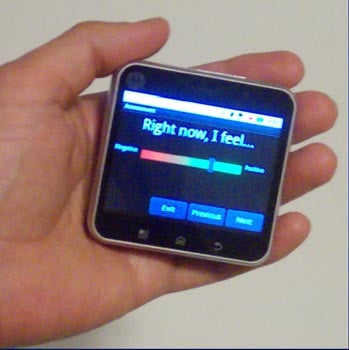 |
|
iHeal combines sensors to measure physiological changes and detect trigger points for risky health behaviors. |
Clinical researchers at UMass Medical School are combining an innovative constellation of technologies to prevent and treat drug abuse. These emerging technologies, such as artificial intelligence, smartphone programming, biosensors and wireless connectivity, are being used in a device that detects physiological stressors associated with drug cravings and responds with user-tailored behavioral interventions that prevent substance abuse. Preliminary data about the multi-media device, called iHeal, was published online in the Journal of Medical Toxicology.
According to the study’s authors, many behavioral interventions used to treat patients are ineffective outside the controlled clinical settings where they are taught. This failure can be attributed to several factors, including a patient’s inability to recognize biological changes that indicate increased risk of relapse and an inability to change their behaviors to reduce health risk.
Edward Boyer, MD, PhD, professor of emergency medicine and lead author of the study, worked with colleagues at UMMS and at the Massachusetts Institute of Technology to design a mobile device equipped with enabling technologies that could make behavioral interventions for substance abusers more effective outside the clinic or office environments. The device they created, iHeal, combines sensors to measure physiological changes and detect trigger points for risky health behaviors such as substance use, with smartphone software tailored to respond with patient-specific interventions.
Individuals with a history of substance abuse and post-traumatic stress disorder were asked to wear an iHeal sensor band around their wrist that measures the electrical activity of the skin, body motion, skin temperature and heart rate—all of which can reveal levels of stress. The band wirelessly transmits information to a smartphone, where software applications monitor and process the user’s physiological data. When the software detects an increased stress level, it asks the user to annotate events by inputting information about their perceived level of stress, drug cravings and current activities. This information is then used to identify, in real-time, drug cravings and deliver personalized, multi-media interventions precisely at the moment of greatest physiological need.
Boyer and his teams examined the iHeal system architecture, as well as preliminary feedback from initial users, to identify key attributes and assess the device’s viability. Their analyses suggest a number of technical issues related to data security, as well as the need for a more robust and less stigmatizing version before the device could be worn in public.